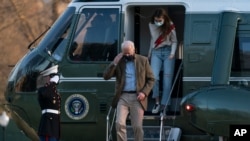U.S. President Joe Biden and other Democrats are embarking this week on visits to numerous states to promote the benefits of the $1.9 trillion coronavirus relief package Biden signed into law last week, hoping to make sure voters know how the aid could help them and that it was approved over uniform Republican opposition.
Biden is scheduled to discuss the plan in remarks at the White House on Monday, while his wife, Jill, goes to the state of New Jersey to join Governor Phil Murphy at an elementary school where she is expected to talk about steps the school took to reopen and how the relief package can help families.
Vice President Kamala Harris travels Monday to Las Vegas where she will visit a COVID-19 vaccination site.
Biden makes his first trip promoting the relief plan Tuesday when he goes to Delaware County, a key suburban Philadelphia jurisdiction in the eastern state of Pennsylvania that he carried over former President Donald Trump in the November election.
The relief package is one of the largest economic assistance packages in U.S. history and the first major legislative victory for Biden. It was approved solely with the votes of Democrats. Republican lawmakers objected to the size of the deal and to the fact that some of the funding is not tied directly to trying to end the pandemic in the United States, where more than 534,000 Americans have died.
Biden said in a speech Thursday night that members of his administration will spread out across the country to “speak directly” to Americans about the plan.
Biden and the other Democrats plan to highlight that millions of adult Americans, all but those in the upper-income brackets, will receive $1,400 stimulus checks, with tax credits for children. Billions of dollars are being sent to state and local governments and businesses that have been hit hard by the yearlong pandemic in the United States. Additional aid is being spent to boost vaccinations of millions of Americans.
The president and his aides hope to highlight how much assistance is being spent in individual states. National polls have shown that the relief package has wide support, even among Republicans, but Biden is not taking its popularity for granted.
Democrats are mindful that in 2009, the last Democratic president, Barack Obama, under whom Biden served as vice president, spent little time promoting the $800 billion economic stimulus package he and fellow Democrats helped push through Congress to help rescue the U.S. economy from the steep recession they inherited from Republican President George W. Bush.
Republicans, who mostly opposed the stimulus, went on to capture the House of Representatives in the 2010 elections.
Biden press secretary Jen Psaki, a veteran of the Obama administration, told reporters last week: “We didn’t do enough to explain to the American people what the benefits were” in 2009.
The White House is planning to make surrogates and senior administration officials available for local television interviews in cities across the country and get more than 400 mayors and governors to talk about what the relief package means for them and their communities.
Congresswoman Liz Cheney, the House’s No. 3 Republican, said in a statement that only a small fraction of the $1.9 trillion deal was aimed at the virus and warned that it might eventually lead to tax increases to help pay for it.










